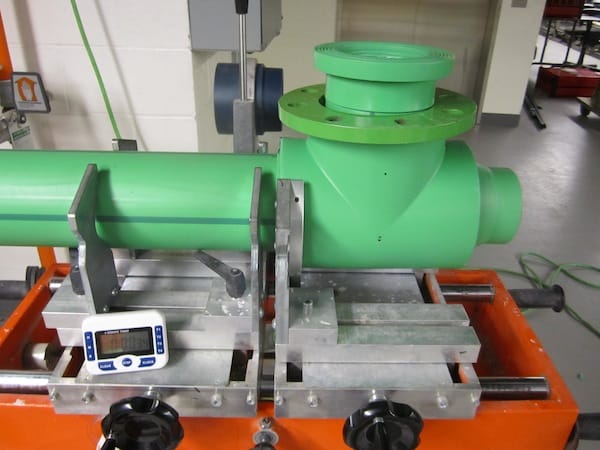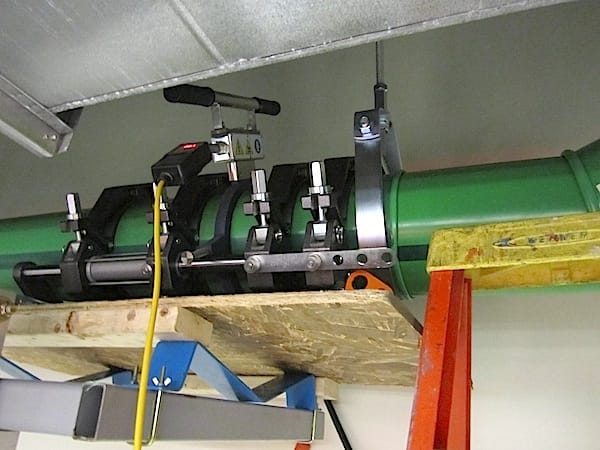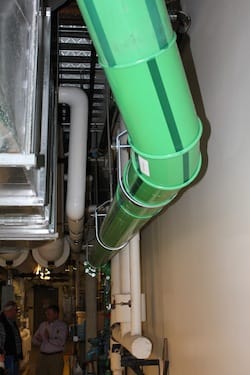 In January 2013, a major pharmaceutical manufacturer located in the Northeast faced a domestic water piping retrofit at one of its biopharmaceutical research centers. DECCO, a Brookline, NH-based mechanical contractor that has extensive experience in the mechanical aspects of “bio-pharm” applications, was called upon as a project engineer to come up with a solution.
In January 2013, a major pharmaceutical manufacturer located in the Northeast faced a domestic water piping retrofit at one of its biopharmaceutical research centers. DECCO, a Brookline, NH-based mechanical contractor that has extensive experience in the mechanical aspects of “bio-pharm” applications, was called upon as a project engineer to come up with a solution.
In spring of 2013, the research facility’s staff determined that the time had come to replace a portion of the city water main that feeds different domestic and lab distribution lines, approximately 160 ft of 8 in. and 10 in. piping. The research facility’s engineering staff needed a reliable solution that could be implemented quickly.
DECCO, an 80-year-old firm with expertise in process and utility piping installation, process and laboratory plumbing, specialty gas and chemical piping installation, turnkey tool/equipment installation, and a broad range of support services, worked with the facility staff to explore alternative piping options.
Copper and stainless steel were considered but both materials were costly. Furthermore, since stainless steel isn’t approved for drinking water in the state of Massachusetts, the facility manager didn’t want to try securing a variance for stainless approval. The design team toiled over possible piping methods, but one stood out. Many factors played into which pipe would be specced for the job — from installation time to non-corrosive piping materials to cost, but all indicators pointed to Aquatherm Green Pipe®.
 Aquatherm Green Pipe is a polypropylene-random (PP-R) pressure piping system, designed for hot and cold potable water and food-grade applications. When installed properly, Aquatherm Green Pipe is designed to last for more than 60 years without repairs or maintenance. It was the least expensive option and was priced 15-20% less than copper and steel for this job. And, perhaps most importantly in this application, Aquatherm Green Pipe is the only plastic piping system approved for unrestricted commercial potable water use in the state of Massachusetts.
Aquatherm Green Pipe is a polypropylene-random (PP-R) pressure piping system, designed for hot and cold potable water and food-grade applications. When installed properly, Aquatherm Green Pipe is designed to last for more than 60 years without repairs or maintenance. It was the least expensive option and was priced 15-20% less than copper and steel for this job. And, perhaps most importantly in this application, Aquatherm Green Pipe is the only plastic piping system approved for unrestricted commercial potable water use in the state of Massachusetts.
The Decision was Green
The task at hand was to replace the 8-in., badly corroded Schedule 40 galvanized steel water line, which served the building’s domestic and lab water needs. The water line ran approximately 50 ft. from the meter room through a loading dock area. It then ran straight out into the main mechanical room, where it reduced to 6-in. and 4-in. and connected to the existing lines using flanged connections.
 The time was ripe for a much-needed upgrade, as the existing galvanized steel system had been corroding over the years, causing concern for water quality, incoming gpm levels, and reduced inner diameter (ID) piping issues due to scale buildup and corrosion. The facility engineers were drawn to the Aquatherm pipe because of its resistance to scaling. They were also reassured knowing their piping system was designed to last more than 60 years.
The time was ripe for a much-needed upgrade, as the existing galvanized steel system had been corroding over the years, causing concern for water quality, incoming gpm levels, and reduced inner diameter (ID) piping issues due to scale buildup and corrosion. The facility engineers were drawn to the Aquatherm pipe because of its resistance to scaling. They were also reassured knowing their piping system was designed to last more than 60 years.
Initially the design team planned to use 8-in. Aquatherm Green Pipe but they hadn’t realized the Aquatherm pipe ID would be smaller than that due to pipe thickness. In order to get the required equivalent flow, they needed 10-in. Aquatherm pipe. “Once we saw the pipe and the wall thickness, we were pretty good with it. We did have initial concerns about the gpm flow, which is why we went from the 8-in. inner diameter; we ended up going from 6- and 8-in. pipe to 8- and 10-in. pipe to accommodate the difference,” said Mark Terry, Vice President of Plumbing Services with DECCO.
 Another key benefit offered by Aquatherm was the ability to install branch lines after the pipe is already in place. Fusion outlets can be welded into the side wall of the pipe anywhere on the pipe that is accessible.
Another key benefit offered by Aquatherm was the ability to install branch lines after the pipe is already in place. Fusion outlets can be welded into the side wall of the pipe anywhere on the pipe that is accessible.
“With other brands of polypropylene, contractors would have to install reducing tees with several added step-down reducers, making branch connections much longer and more obtrusive not to mention more time consuming. The thread-o-let fittings are integrated with a threaded brass piece molded right into the fitting so we can thread a low point drain or high point vent valve directly to the fusion outlet,” said Brian Meldrum, Project Manager, P.E., DECCO.
Back at the Shop/Onsite Solutions
A majority of the piping was prefabricated back at DECCO’s shop and the 22-degree elbows were fabricated at the Aquatherm custom fabrication facility in Lindon, UT. Time was of the utmost importance. The prefabrication process was expected to take 10 days prior to the installation. Then, the actual installation needed to be completed in a weekend.
 Unfortunately, DECCO’s plan to spend 10 days prefabbing was partly disrupted by the commotion and concerns that arose from the Boston Marathon bombing as material deliveries were slightly delayed due to transportation limitations around the city of Boston. “There were five of us prefabbing back at the shop. The weekend installation was a 10-hour day and a 14-hour day. We certainly would have had more man hours if we were soldering or welding; a lot more with welding, probably 40 percent more,” said Terry.
Unfortunately, DECCO’s plan to spend 10 days prefabbing was partly disrupted by the commotion and concerns that arose from the Boston Marathon bombing as material deliveries were slightly delayed due to transportation limitations around the city of Boston. “There were five of us prefabbing back at the shop. The weekend installation was a 10-hour day and a 14-hour day. We certainly would have had more man hours if we were soldering or welding; a lot more with welding, probably 40 percent more,” said Terry.
Lending as much support to the project as possible, Aquatherm deployed its chief training officer, Buddy Finley, to facilitate the project. Manufacturer’s rep, Chip Curtis from NextGen Energy Solutions (Boston), was also on-site to lend his expertise along with leading pipe, valves, fittings (PVF) supplier Charles D. Sheehy, Inc., (Avon, MA). All combined to provide an unmatched level of collective support throughout the piping makeover.
NextGen specializes in marketing and supporting the latest in green and energy-efficient heating and cooling solutions, and provided much-appreciated, comprehensive support. “It really helped us. In my mind, we were a week or two behind. The fact that they sent the trainer and rep out to spend several days here helped speed up the learning curve. They were tremendously helpful with the prefabrication process, as well,” said Terry.
Challenges Met
One of the challenges encountered while installing the pipe was space limitations. The DECCO team met this challenge by using electrofusion, a method of socket fusion that does not require heating irons. The pipe is joined by running an electrical current through a special fitting, rather than heating the pipe and fitting directly.
 The contractors used this method because some of the piping was up against the ductwork on the other side of a 16-in.-thick concrete wall, and they couldn’t get the butt welding machine into the space. They took a 19-ft section of Green Pipe and hoisted it into the air with a scissor lift and then electrofused it into place. “We knew that the install was going to be a lot easier doing it this way, rather than putting a 20-in. hole in that concrete wall to get a flange through there. The electrofusion process worked out well and we got the job done,” said Terry.
The contractors used this method because some of the piping was up against the ductwork on the other side of a 16-in.-thick concrete wall, and they couldn’t get the butt welding machine into the space. They took a 19-ft section of Green Pipe and hoisted it into the air with a scissor lift and then electrofused it into place. “We knew that the install was going to be a lot easier doing it this way, rather than putting a 20-in. hole in that concrete wall to get a flange through there. The electrofusion process worked out well and we got the job done,” said Terry.
 “It was the first time we had done electrofusion on a water main that would be under pressure. We did one electrofusion on each side of that wall. We had to cut it and get as much as possible in the air then we pre-tested the connections prior to installation. In the end, there were no performance issues at all,” said Meldrum.
“It was the first time we had done electrofusion on a water main that would be under pressure. We did one electrofusion on each side of that wall. We had to cut it and get as much as possible in the air then we pre-tested the connections prior to installation. In the end, there were no performance issues at all,” said Meldrum.
Similar to mid-air execution, there were some instances DECCO installers had a lift in place, put one length of piping up, and slid it through the wall and then made a joint, then pushed it through the wall and made another connection.
Turning Heads
After completion of the installation, even the local inspector was impressed with the Aquatherm installation. “He hadn’t seen this type of piping material before this site and was impressed with the installation. He was impressed with the way we were able to make the routing and elevation changes, and do the fusion connections in the tight quarters in which we worked,” said Meldrum.
 Overall, the facility engineering team was looking to eliminate the pipe problems it had experienced, while also reducing its environmental footprint. Since Aquatherm is fully recyclable, rust- and corrosion-free and long-lasting, the first part of the objective was met. Further, since the polypropylene material used to make it requires less energy for initial production than other piping materials, and involves none of the environmental effects associated with mining operations, it helped them realize the second part of that goal.
Overall, the facility engineering team was looking to eliminate the pipe problems it had experienced, while also reducing its environmental footprint. Since Aquatherm is fully recyclable, rust- and corrosion-free and long-lasting, the first part of the objective was met. Further, since the polypropylene material used to make it requires less energy for initial production than other piping materials, and involves none of the environmental effects associated with mining operations, it helped them realize the second part of that goal.
With the job now wrapped up, everyone is pleased with the positive results, so much so that the team, including the owner, continues to look for other applications where Aquatherm can be used.





Join the conversation: